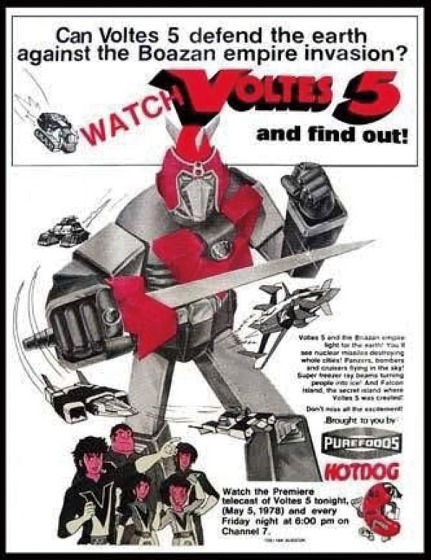『超電磁マシーン ボルテスV(ファイブ)』――「原産地」である日本では、1970年代に量産されたロボットアニメの一つに過ぎず、決して知名度は高いとは言えない。しかし、ここフィリピンでは国民的アニメの地位を確立しており、主題歌の知名度は国歌に次ぐとさえ言われる。現在まで9回放送され、実写版ドラマも今年民放大手GMAで放送予定だ。なぜ、ボルテスVはこれほどフィリピン国民に愛されるに至ったのか。日本のサブカルに詳しいアテネオ・デ・マニラ大学のチェンチュア先生に、フィリピンにおける日本アニメ史を聞いた。

「ボルテスVはボアサン帝国から地球を守ることができるのか!?」と銘打った1978年当時の新聞広告 Newspaper advertisement featuring Voltes V appeared in 1978(Photo courtesy of Dr. Karl Ian Uy Cheng Chua)
マジンガーZよりボルテスV
フィリピンではテレビが一般家庭に普及してきた1970年代後半からテレビアニメ放送が始まった。最初のアニメーションは『トムとジェリー』などの米国製。そうした中、メディア会社クエスターが『マジンガーZ』や『闘将ダイモス』など、70年代の日本のロボットアニメ5作品の放送権を買い取る。その中にボルテスVもあった。
これらのアニメは78年5月から平日の午後6時~6時半という家族で視聴できる時間帯に放送。スポンサーが5つの作品のうちボルテスVだけを好んだため、大々的に宣伝された。さらに放送日も視聴率が高い金曜日。そのかいあって最高視聴率は58%を記録した。
戒厳令下の日本アニメ
カルト的人気作となったボルテスVだが、最後の4話を残したところでマルコス政府が放送中止を命令。理由は諸説ある。戒厳令下で「帝国に対する抗戦」をテーマとする同作は政府に不都合だった説、放送していたGMA―7は当時唯一の非政府系放送局だったため攻撃を受けたという説などだ。
ただ当時、カトリック女性団体が暴力表現を理由に放送中止を求める嘆願書を政府に提出していた。作中キャラのリトルジョン(剛日吉)の声優セリナ・クリストバルさんも「カトリック団体からの圧力とそれを支持する中間層の親たちの声にマルコス大統領は応えた」と証言。さらに、他ロボットアニメが同時に放送中止された一方で、『キャンディ♡キャンディ』などは同時期に家族向けコンテンツとして放送されていたことから、単なる暴力表現規制だった可能性もある。
海賊版を買い求めるファンたち
放送業界の自由化が進んだ92年以降、民放ABS-CBNが放送言語のフィリピン語化を進める。日本アニメのフィリピン語吹き替えもこの頃から始まった。最初のフィリピン語吹き替え日本アニメ『小公子セディ』『小公女セーラ』は大ヒット作となった。90年代中期には、『ドラゴンボールZ』『セーラームーン』『らんま1/2』をはじめとするアニメがあふれた。ただ、米国経由で入ってくるためキャラ名の変更やオープニングの主題歌がカットされるなど日本の要素を薄める習慣は続く。だが、日本の「アニメ」を米国の「カートゥーン」(cartoon)と区別するようになったファンたちはこれを嫌い、ファンが字幕を付けた海賊版ビデオを販売する店に殺到した。
インターネットの時代になると、ファンはファイル共有ソフト上でコミュニティーを作り、ファン字幕付き海賊版アニメを共有。テレビ局の吹き替え担当者は、ファン字幕を参照して吹き替えの正確さを確認するという倒錯現象も発生した。
ボルテスVの復活
98年、あるテレビ番組がボルテスVの歌を放送したところ大反響となる。これを機に99年、フィリピン語吹き替え版が制作され、ブームが再燃。その後も多数の吹き替え版が制作され、2017年には5回目の吹き替え版が放送。こうしてボルテスVは世代を超えた国民的アニメとなった。
ただ概して、日本は著作権に厳格だった上に、フィリピンを有望な市場として見ていなかったという印象だ。そんな中でも、海賊版を通じて「アニメ」「マンガ」は着実にローカルに浸透している。今年の大統領選でレニ・ロブレド候補の支持者たちは、日本のアニメ風のテーマソングビデオを制作したほどだ。「マンガ」の影響を色濃く受けた作風のフィリピン産コミックも多い。

カール・イアン・ウイ・チェンチュア先生
アテネオ・デ・マニラ大学助教、国際交流基金研究員として一橋大学在籍中。
1980年生まれ。イロイロ市出身。一橋大学で博士号取得。
最近夢中なこと:日本の人々との触れ合い。
Dr. Karl Ian Uy Cheng Chua
Assistant Professor at Ateneo de Manila University, Japan Foundation Research Fellow at Hitotsubashi University, Tokyo
Ph.D. ( Hitotsubashi University )
Born : 1980 Home :IloIlo City
Hobby : interaction with Japanese locals
VOLTES V and Japanese Anime in the Philippines
VOLTES V is a Japanese anime, which only a few people know
in Japan but, almost all the Filipinos know. The theme song,
“Voltes V no Uta” is said to be the second most known song to the national anthem in the Philippines. Why and how did Filipinos come to love Voltes V and adopt Japanese anime?
Navi Manila interviews Dr. Karl Ian Uy Cheng Chua who specializes in Japanese pop-cultures.
Voltes V Beat Mazinger Z
In the Philippines, Cartoons began to be broadcast in the 1970s, when TV ownership increased in the Philippines. The first cartoons aired, such as Tom and Jerry, all came from U.S. In the late 70’s, a media company, Questor, whose CEO had watched anime in Japan, bought the broadcasting rights of 5 robot anime titles, including Mazinger Z and Voltes V. The five titles began broadcast in the first week of May, 1978.
Thanks to “random interest of corporate sponsors” of the five titles, Voltes V was largely advertised. In addition, it was broadcast on Fridays, when higher viewership was garnered. As a result, the viewer ratings of Voltes V reached a peak of 58%.
Japanese Anime under Martial Law
Voltes V became a cult favorite, but before the last four episodes could be aired, the government ordered the show off the air. There are various speculations as to why: One theory was that the Marcos Martial Law government found it might lead to uprising because of the anime’s theme of “rebelion against a dictator.” Another was that GMA-7, the only non-governmental broadcasting station at the time, was under attack by the regime.
On the other hand, a Catholic women’s group submitted a petition to the government demanding that Voltes V broadcast be stopped due to the violent scenes. Selina Cristobal, who played Little John (Go Hiyoshi), testified that “President Marcos responded to the pressure from the Catholic groups and middle-class parents. As a result, Voltes V was taken off the air along with the five other robot anime shows. However, Japanese anime itself was not banned. Candy♡Candy and others continued to be broadcast as family-friendly cartoons.
Filipinization and “Fansub”
After the liberalization of the telecommunication industry in 1992, private broadcasting company ABS-CBN began to use Filipino as their broadcasting lnaguage. The Filipino dubbing of cartoons also began around this time. In the mid-90s, there was a flood of anime such as Dragon Ball Z, SailorMoon, and Ranma 1/2. However, this included the practice of diluting the works’ Japanese tastes by localizing character’s names and cutting opening songs. Filipino anime fans who disliked this, went to shops selling pirated anime with fan-produced subtitles.
Voltes V is Back
In 1998, a TV program aired a song about Voltes V and it became a huge sensation. This led to the production of a Filipino dubbed version in 1999. Numerous dubbed versions have been produced since then, and the fifth dubbed version was broadcasted in 2017. It is now a multigenerational national anime.
However, my general impression is that Japan observed strict copyright laws and did not see the Philippines as a lucrative market. However, “anime” and “manga” have so deeply penetrated Philippine society through piracy that they have become local. For example, supporters of Leni Robredo had made a Japanese anime version of the music clip of her theme song for her presidential campaign, and the aesthetics of many Philippine komiks (comics) are influenced by manga.
Photo courtesy of Dr. Karl Ian Uy Cheng Chua















